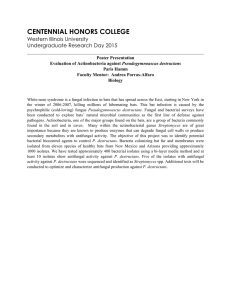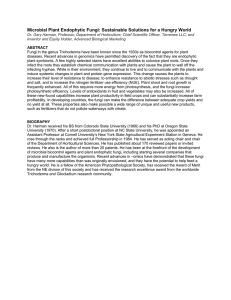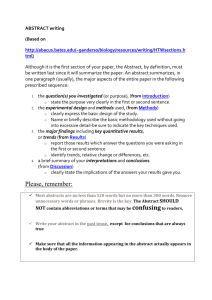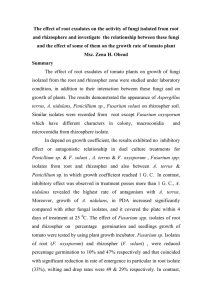Document 13310630
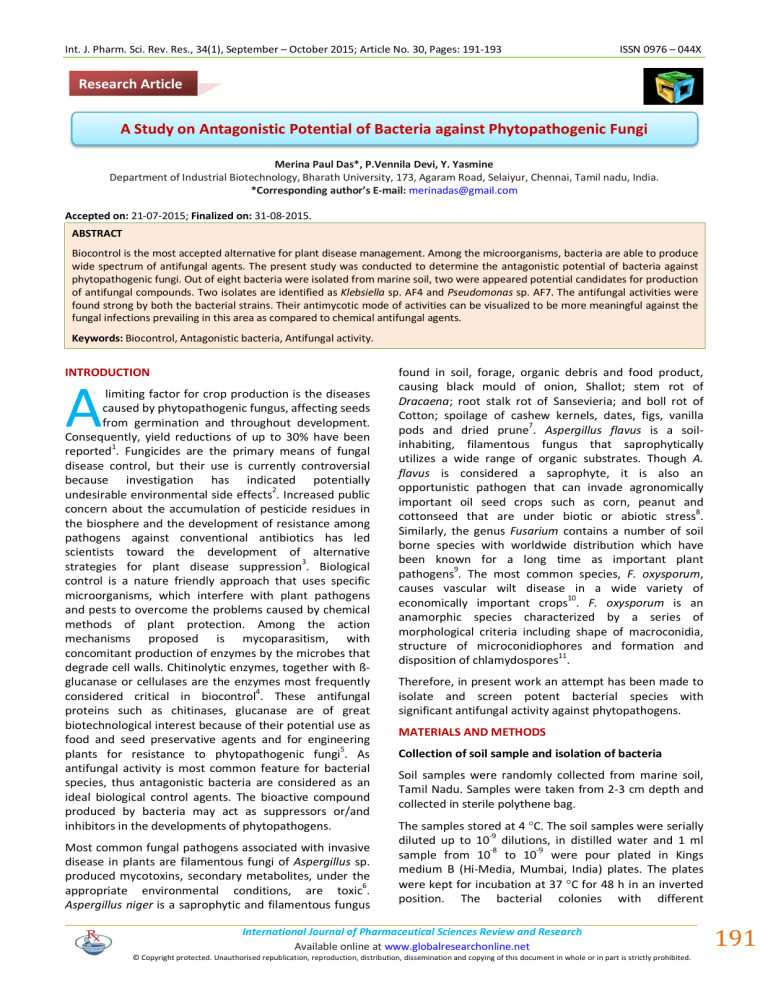
Int. J. Pharm. Sci. Rev. Res., 34(1), September – October 2015; Article No. 30, Pages: 191-193 ISSN 0976 – 044X
Research Article
A Study on Antagonistic Potential of Bacteria against Phytopathogenic Fungi
Merina Paul Das*, P.Vennila Devi, Y. Yasmine
Department of Industrial Biotechnology, Bharath University, 173, Agaram Road, Selaiyur, Chennai, Tamil nadu, India.
*Corresponding author’s E-mail: merinadas@gmail.com
Accepted on: 21-07-2015; Finalized on: 31-08-2015.
ABSTRACT
Biocontrol is the most accepted alternative for plant disease management. Among the microorganisms, bacteria are able to produce wide spectrum of antifungal agents. The present study was conducted to determine the antagonistic potential of bacteria against phytopathogenic fungi. Out of eight bacteria were isolated from marine soil, two were appeared potential candidates for production of antifungal compounds. Two isolates are identified as Klebsiella sp. AF4 and Pseudomonas sp. AF7. The antifungal activities were found strong by both the bacterial strains. Their antimycotic mode of activities can be visualized to be more meaningful against the fungal infections prevailing in this area as compared to chemical antifungal agents.
Keywords: Biocontrol, Antagonistic bacteria, Antifungal activity.
INTRODUCTION
A limiting factor for crop production is the diseases caused by phytopathogenic fungus, affecting seeds from germination and throughout development.
Consequently, yield reductions of up to 30% have been reported
1
. Fungicides are the primary means of fungal disease control, but their use is currently controversial because investigation has indicated potentially undesirable environmental side effects
2
. Increased public concern about the accumulation of pesticide residues in the biosphere and the development of resistance among pathogens against conventional antibiotics has led scientists toward the development of alternative strategies for plant disease suppression
3
. Biological control is a nature friendly approach that uses specific microorganisms, which interfere with plant pathogens and pests to overcome the problems caused by chemical methods of plant protection. Among the action mechanisms proposed is mycoparasitism, with concomitant production of enzymes by the microbes that degrade cell walls. Chitinolytic enzymes, together with ßglucanase or cellulases are the enzymes most frequently considered critical in biocontrol
4
. These antifungal proteins such as chitinases, glucanase are of great biotechnological interest because of their potential use as food and seed preservative agents and for engineering plants for resistance to phytopathogenic fungi
5
. As antifungal activity is most common feature for bacterial species, thus antagonistic bacteria are considered as an ideal biological control agents. The bioactive compound produced by bacteria may act as suppressors or/and inhibitors in the developments of phytopathogens. found in soil, forage, organic debris and food product, causing black mould of onion, Shallot; stem rot of
Dracaena; root stalk rot of Sansevieria; and boll rot of
Cotton; spoilage of cashew kernels, dates, figs, vanilla pods and dried prune
7
. Aspergillus flavus is a soilinhabiting, filamentous fungus that saprophytically utilizes a wide range of organic substrates. Though A.
flavus is considered a saprophyte, it is also an opportunistic pathogen that can invade agronomically important oil seed crops such as corn, peanut and cottonseed that are under biotic or abiotic stress
8
.
Similarly, the genus Fusarium contains a number of soil borne species with worldwide distribution which have been known for a long time as important plant pathogens
9
. The most common species, F. oxysporum, causes vascular wilt disease in a wide variety of economically important crops
10
. F. oxysporum is an anamorphic species characterized by a series of morphological criteria including shape of macroconidia, structure of microconidiophores and formation and disposition of chlamydospores
11
.
Therefore, in present work an attempt has been made to isolate and screen potent bacterial species with significant antifungal activity against phytopathogens.
MATERIALS AND METHODS
Collection of soil sample and isolation of bacteria
Soil samples were randomly collected from marine soil,
Tamil Nadu. Samples were taken from 2-3 cm depth and collected in sterile polythene bag.
Most common fungal pathogens associated with invasive disease in plants are filamentous fungi of Aspergillus sp. produced mycotoxins, secondary metabolites, under the appropriate environmental conditions, are toxic
6
.
Aspergillus niger is a saprophytic and filamentous fungus
The samples stored at 4 C. The soil samples were serially diluted up to 10
-9 sample from 10 position. The
-8
dilutions, in distilled water and 1 ml
to 10
-9 bacterial
were pour plated in Kings medium B (Hi-Media, Mumbai, India) plates. The plates were kept for incubation at 37 C for 48 h in an inverted colonies with different
International Journal of Pharmaceutical Sciences Review and Research
Available online at www.globalresearchonline.net
© Copyright protected. Unauthorised republication, reproduction, distribution, dissemination and copying of this document in whole or in part is strictly prohibited.
191
© Copyright protected. Unauthorised republication, reproduction, distribution,
Int. J. Pharm. Sci. Rev. Res., 34(1), September – October 2015; Article No. 30, Pages: 191-193 ISSN 0976 – 044X characteristics were selected and purified by pure culture techniques and refrigerated in nutrient agar slants for further studies. practical life through the use of bacterial antagonists to protect crops against their fungal enemies
19
.
Isolation and identification of antagonistic strain
Isolation and culture conditions of test organisms
The target fungi were chosen to represent potential pathogenic fungi causing plant diseases. Three fungi samples, Aspergillus niger, Aspergillus flavus, Fusarium
oxysporum were collected from infected plant sample.
Fungi were grown on Potato Dextrose agar (PDA, Hi-
Media, Mumbai, India) plates at 25 C for 5 d, and stored at 4 C. The cultures were further purified by single spore isolation technique
12
.
Identification of fungi
The isolated fungi were identified to the genus and species level on the basis of macro- and micromorphological characteristics using the most updated keys for identifications
13-15
.
A total of 8 bacteria isolated from various coastal area of
Tamil Nadu were screened on the bases of fungal growth inhibition. The clear zones were due to antifungal compound produced by bacterial culture. Out of eight, two isolates AF4 and AF7 were found to be the best antifungal agent and were further analyzed for the rest of the studies. Result of Table 1 revealed that the isolate
AF4 is a gram-negative, non-motile rod shaped bacterium with Catalase, Urease, Nitrate reduction positive reactions, Oxidase, Methyl red negative reactions, where isolate AF7 is gram-positive, motile, rod shaped bacterium with Catalase, Oxidase, Voges-Proskauer positive reactions, Methyl red, Indole production negative reactions. Based on the physiochemical, morphological characteristics, the isolates AF4 and AF7 were identified as Klebsiella sp. and Pseudomonas sp., respectively.
Screening of antagonistic bacteria
All isolated bacteria were tested for antifungal activity. A
1-cm
2
fungal plug (any one of targeted fungi) was inoculated in the center of a plate with PDA, each isolated bacterium was streak with a sterile stick at a distance of
2.5 cm from the fungus. The plates were then incubated at 37 C for 72 h. The strains showed inhibitions of fungal growth were screened for further studies.
Identification of active isolates
The potent isolates selected were characterized by morphological and biochemical methods. The results of microscopic examination were compared with Bergey's manual of systematic bacteriology
16,17
and the organism was identified upto genus level. Various biochemical tests were performed for the identification of the potent isolates are as follows; Fermentation of sugars, Hydrolysis of starch, Indole production, Methyl red, Voges-
Proskauer, Citrate utilization, Nitrate reduction test,
Catalase test, Oxidase test.
Table 1: Morphological, physiological and biochemical characteristics of the isolated strain AF4 and AF7
Characters
Morphology
Motility
Catalase
Oxidase
Methy red
Voges-
Proskauer
Indole production
Citrate utilization
-ve
-ve
+ve
Results
AF4
Rod shaped, gram -ve, facultative anaerobic
-ve
+ve
-ve
-ve
AF7
Rod shaped, gram
+ve, Obligate aerobe
+ve
+ve
+ve
-ve
+ve
-ve
+ve
Nitrate reduction
+ve +ve
Antagonistic activity assay
Antagonistic activity assay were performed to assess the potential biocontrol activity of active bacterial isolates in
vitro by inhibiting the growth of phytopathogenic fungus on PDA media
18
.
Hydrolysis of urea
Fermentation with Glucose
+ve
+ve
+ve
+ve
The bacterial inoculum of the active isolates was picked aseptically and streaked in the center of petridish. Fungal inocula consisted of agar disc (1 cm diameter) punched out with sterilized corkborer from the growing margin of colonies was placed on either side of bacteria inoculated plates. The Petri plates were incubated at 37 days. The diameter of inhibition zones were measured and experiment was repeated three times.
C for three
RESULTS AND DISCUSSION
The production of antifungal substances by bacteria has long been recognized and this knowledge is entering
Lactose
Sucrose
+ve
+ve
Determination antifungal activity
-ve
-ve
The antifungal effect of isolated two bacterial cultures,
Klebsiella sp. AF4, and Pseudomonas sp. AF7 was tested against the three plant pathogen fungal strains, such as,
Aspergillus niger, Aspergillus flavus, Fusarium oxysporum individually (Figure 1). The performed experiments showed that all the phytopathogenic fungi are very sensible to biocontrol agents. The fungal growth inhibition was recorded after 72 h of incubation. The
International Journal of Pharmaceutical Sciences Review and Research
Available online at www.globalresearchonline.net
© Copyright protected. Unauthorised republication, reproduction, distribution, dissemination and copying of this document in whole or in part is strictly prohibited.
192
© Copyright protected. Unauthorised republication, reproduction, distribution,
Int. J. Pharm. Sci. Rev. Res., 34(1), September – October 2015; Article No. 30, Pages: 191-193 ISSN 0976 – 044X evaluation of the antagonism was based on zone of inhibition. The active isolate Klebsiella sp. AF4 showed effective biocontrol potential against F. oxysporum, A.
niger with zone of inhibition of 19 mm, 15 mm, respectively, where it reduced to 10 mm for A. flavus.
While in case of Pseudomonas sp. AF7 have exercised highest antifungal activity against A. flavus of 31 mm, and against A. niger, F. oxysporum of 28 mm, 27 mm inhibition zone, respectively. Among these two isolates,
Pseudomonas sp. AF7 effectively suppressed the colony growth of all tested phytopathogenic fungi.
Figure 1: Antagonistic potential of bacterial isolates against phytopathogenic fungi
CONCLUSION
Biocontrol is the new approach for controlling the damage caused by fungal pathogens and reducing the pollution that results from the use of chemical fungicides.
Here two promising bacterial cultures isolated from marine environment, which showed a significant in vitro antagonistic activity toward different phytopathogenic fungi. These isolates were synthesized antifungal agents which act to protect plants against attack by pathogenic fungi. These observations and further studies will help in developing the Klebsiella sp. AF4 and Pseudomonas sp.
AF7 isolates as a potential biological control agent against
Aspergillus niger, Aspergillus flavus, Fusarium oxysporum.
REFERENCES
1.
Reyes-Ramírez A, Escudero-Abarca BI, Aguilar-Uscanga G,
Hayward-Jones PM, Eleazar Barbozacorona J, Antifungal
Activity of Bacillus thuringiensis Chitinase and Its Potential for the Biocontrol of Phytopathogenic Fungi in Soybean Seeds,
Journal of Food Science: Food Microbiology and Safety, 69(5),
2004, 131–134.
2.
Carlile WR, "Fungicides". In W.R. Carlile (Ed.). Control of Crop
Diseases. Edward Arnold Publisher, London, 1988, 51–58.
3.
Omar M Al-Obaidy, Isolation and Identification of Wide-
Spectrum Antifungal Bacteria, Rafidain Journal of Science,
21(4), 2010, 1–10.
4.
Anand S, Jayarama Reddy, Biocontrol potential of Trichoderma
Sp. against plant pathogens, International Journal of
Agriculture Sciences, 1(2), 2009, 30–39.
5.
Dempsey DMA, Silva H, Klessig DF, Engineering disease and pest resistance in plants, Trends in Microbiololy, 6, 1998, 54–
61.
6.
Bennett JW, Klich M, Mycotoxins, Clinical Microbiology
Reviews, 16(3), 2003, 497–516.
7.
Bobbarala V, Katikala PK, Naidu KC, Penumajji S, Antifungal activity of selected plants extracts against phytopathogenic fungi Aspergillus niger, Indian Journal of Science and
Technology, 2009, 87–90.
8.
Duran RM, Cary JW, Calvo AM, The Role of veA in Aspergillus
flavus Infection of Peanut, Corn and Cotton, The Open
Mycology Journal, 3, 2009, 27–36.
9.
Moss MO, Smith JE, The Applied Mycology of Fusarium.
Cambridge University Press, 1984.
10.
Beckman CH, The Nature of Wilt Diseases of Plants. St Paul,
MN: American Phytopathological Society, 1987.
11.
Isabel G Roncero M, Concepcio´n Hera, Manuel Ruiz-Rubio,
Garcı´a Maceira Fe I, Marta P Madrid, Zaira Caracuel, Fern ando
Calero, Jesu´s Delgado-Jarana, Raquel Rolda´nRodrı´guez, Ana
Lilia Martı´nez -Rocha, Carmen Velasco, Juan Roa, Magdalena
Martı´n -Urdiroz, Dolores Co´rdoba, Antonio Di Pietro,
Fusarium as a model for studying virulence in soil borne plant pathogens, Physiological and Molecular Plant Pathology, 62,
2003, 87–98.
12.
Choi YW, Hyde KD, Ho WH, 1999. Single spore isolation of fungi, Fungal Diversity, 3, 1999, 29–38.
13.
Raper KB, Fennell DI, The genus Aspergillus, R.E. Krieger(Ed).
Huntington, NewYork, 1987, 686.
14.
Pitt JI, The genus Penicillium and its teleomorphic states
Eupenicillium and Talaromyces. London, Academic Press, 1979.
15.
Domsch KH, Gams W, Anderson TH, Compendium of soil fungi.
London, England:Academic Press, 1980.
16.
Kreig NR, Holt JG, Bergey"s manual of systematic Bacteriology,
(Editorin-chief) Holt JG, Williams & Wilkins, Baltimore, 1, 1984,
1–910.
17.
Kreig NR, Sneath PHA, Mair NS, Sharpe EM, Bergey's manual of systematic Bacteriology, (Editor-in-chief) Holt JG, Williams &
Wilkins, Baltimore, 2, 1984, 911–1504.
18.
Altindag M, Sahin M, Esitken A, Ercisli S, Guleryuz M, Donmez
FM, Sahin, Biological control of brown rot (Moniliana laxa Ehr.) on apricot (Prunus armeniaca L. cv. Hacihaliloglu) by Bacillus,
Burkholdria and Pseudomonas application under in vitro and in
vivo conditions. J. Biol. Cont., 38(3), 2006, 369–372.
19.
Laure Weisskopf, The potential of bacterial volatiles for crop protection against phytophathogenic fungi, Microbial pathogens and strategies for combating them: science, technology and education (A. Méndez-Vilas, Ed.), 2013, 1352–
1363.
Source of Support: Nil, Conflict of Interest: None.
International Journal of Pharmaceutical Sciences Review and Research
Available online at www.globalresearchonline.net
© Copyright protected. Unauthorised republication, reproduction, distribution, dissemination and copying of this document in whole or in part is strictly prohibited.
193
© Copyright protected. Unauthorised republication, reproduction, distribution,
